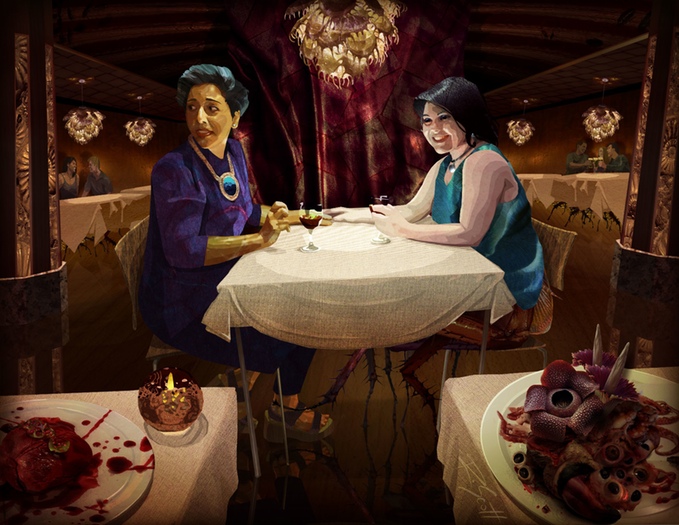If you’re a fan of Lovecraft, you’ve run into the racism, sexism, and ableism (the latter particularly in regards to mental illness) that pervade his stories. For one egregious example of racism, in Herbert West – Reanimator, Lovecraft depicts a boxer, “The Harlem Smoke,” in deeply dehumanizing terms. As far as sexism goes, Lovecraft rarely bothers to include female characters (much less protagonists), but “Innsmouth” poses one striking example of where Lovecraft’s sexism and racism intersect – monstrous miscengenation, slut-shaming, and more! For an example of Lovecraft’s poor treatment of mental illness as a plot device, read “The Thing on the Doorstep,” where mental illness and actual weird happenings are conflated with each other.
Nevertheless, Lovecraft has a diverse fandom that loves to interact with the mythos in many different ways. Sometimes fans ignore these noxious elements, or worse, downplay these elements’ severity and the impact they have on their own work. However, some take on the challenge of addressing Lovecraft’s outdated ideas – and thrive on the adventure that comes with that.
This is the goal of Becky Annison and Joshua Fox – the originators of the beautifully crafted and exhaustively playtested new game, Lovecraftesque. The game’s Kickstarter debuted on September 15th, 2015, and you can read the “bare bones” of the game here. Fundraising for the polished version has exceeded 200% of its initial funding goal, with fourteen days to go.
The creators are part of a newly emergent coterie of designers that are uncovering new ways to use Lovecraft as an artistic lens. Becky and Josh do this in several ways. First, they carefully selected from the conventions built into their medium of choice – tabletop roleplaying games (TRPGs) – to create the most inclusive experience possible. They also took special care with the art and other aesthetic content, endeavoring to provide an experience that rejects the ableist and racist tropes that pervade the original canon of Lovecraft. They also provided guidelines for constructing players’ own Lovecraftian clues and monsters, which strongly encourage players to devise their own horrors. This gives players a deeper investment in the game, as they can integrate their own voices in unique ways, and experience horrors more personal and germane than Lovecraft could ever have imagined on their behalf.
This game deviates in format from most conventional TRPGs like Dungeons and Dragons (or one of the hundreds of other similar games). From a technical standpoint, the game is designed to be an inclusive, open playing field, where each person plays an important role even when they aren’t the focal point of a scene. The designers do this through a GM-less design. What this means is that there is no single “game master” or “dungeon master” (or whatever your preferred term is for ‘person who designs the adventure and runs the non-player characters’). Instead, each player has a role in creating the story, background information, and non-player characters throughout the game. And those roles rotate with scenes, so everyone is given a chance to direct a scene, play the main character, and provide background detail in turn. This means that the gaming experience is more equal, allowing space for multiple visions to combine into a truly exciting experience of play. In this way, voices that ordinarily might be sidelined in a more traditional TRPG are given a chance to shine.
There are three main roles in Lovecraftesque: the hapless protagonist who stumbles into a cosmic mystery, called the Witness. Then there is the Narrator, who is the person in charge of deciding ‘what happens’ when the protagonist does something risky. The Narrator also establishes clues, and depicts the environment and characters. The final role is that of Watchers, who embellish upon the information provided by the Narrator and really focus on the feel and aesthetic of the gameplay. This format is what makes this game different from other mythos games on the market currently.
Original Artwork for Lovecraftesque by Robin Scott
In a manner similar to the anthology She Walks in Shadows, edited by Silvia Moreno-Garcia and Paula R. Stiles, this work aims to explode the restrictive confines of women’s roles in Lovecraftian horror narratives. Lovecraftesque extends this openness beyond gender as well. The Lovecraftesque team’s sample artwork is gorgeous, featuring diverse people presenting a wide rangere of gender expressions, colors, and body shapes. The authors’ commitment to diversity goes beyond the aesthetic elements, and anti-oppressive values are deeply embedded throughout the game. On the Kickstarter, the creators specifically cite their goals as “create brand new Lovecraftian stories, free from these stereotypes” and “respectfully address the impact of the trauma on the human mind, and how to agree on your approach around the gaming table.” The guidelines for the game invite players to choose the session’s premise and tone by explicitly encouraging the players to ban game elements like “going mad,” and “overt or allegorical racism” if those aspects would lessen their enjoyment while playing. To further emphasize their mission, the creators’ stretch goals for the game include essays on race and ability, written respectively by Mo Holkar and Shoshana Kessock.
Becky is clearly excited about one particular part of the game. One of the elements of the original Lovecraft stories that enchants her – and arguably defines the genre – is the way that clues slowly build up over time. This procedural ‘whodunnit,’ while fairly straightforward in fiction writing, is notoriously difficult to execute in game design. The design of Lovecraftesque inverts the standard mystery game plot where players are railroaded into finding all the clues and that concludes with a Sherlock-Holmes-style flourish. Instead, the players all contribute clues throughout the game, which they then use to create their own private theories. At the end, one player volunteers their theory to be the foundation of the climatic scene. As Becky writes, “The mystery feels like it was planned all along when in fact it was improvised from everyone’s contributions.” In this way, this game’s design has achieved a perfect zen in terms of balancing player contributions and creating a plot that has some “ugh, I should have known who dunnit!” value.
Overall, this game is already a valuable contribution to the growing canon of roleplaying games. Spearheaded by a diverse and professional team, with contributions from respected leaders in the roleplaying game industry, Lovecraftesque in its polished form is well poised for a successful splash. Or, rather, a blissfully ominous descent into the depths of the mythos that so many love.
K.N. Granger is a queer white cis person with a radical, social-justice perspective towards games. When not writing, organizing, or playing games, K.N. engages in fanfiction, social justice, classical music, and other activities in New York City. She earns her bread and butter as a therapist and social worker, and specializes in working with older adults. Her games are available on DriveThruRPG and Amazon.com under the auspices of Goldfinch Games. You can find her on Patreon here.
—Please make note of The Mary Sue’s general comment policy.—
Do you follow The Mary Sue on Twitter, Facebook, Tumblr, Pinterest, & Google +?











Published: Oct 8, 2015 08:30 am